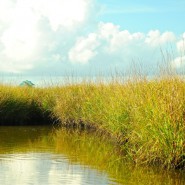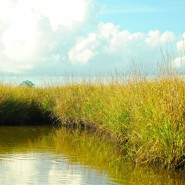2013: The Year In Biodiversity And Wetlands
The year is winding down and the top stories of 2013 in biodiversity and wetlands may be the biggest headlines of 2014 as many of them remain unresolved. The lawsuits in Louisiana over their coastal wetlands are ongoing, as is the decision over how best to conserve the dwindling prairie chicken. Here’s a look back.

The year is winding down and the top stories of 2013 in biodiversity and wetlands may be the biggest headlines of 2014 as many of them remain unresolved. The lawsuits in Louisiana over their coastal wetlands are ongoing, as is the decision over how best to conserve the dwindling prairie chicken. Here’s a look back.
23 December 2013 | We started the new year with a TEEB (The Economics of Ecosystems and Biodiversity) report, emphasizing maintenance and enhancement of wetlands as a key element in a sustainable economy.
Then Forest Trends’ Business and Biodiversity Offsets Programme (BBOP) released an updated Overview document with its Principles on Biodiversity Offsets, introduction to the Standard on Biodiversity Offsets, and supporting materials.
We asked whether biodiversity proponents would embrace business in 2013. October 2012’s Biodiversity COP in Hyderabad, India failed to engage the private sector – largely because business, as the leading destroyer of habitat, is seen as the enemy, writes Joost Bakker of the Global Nature Fund in an opinion piece for Ecosystem Marketplace.
Also in January, the US Supreme Court heard oral arguments in Koontz v. St. Johns River Watershed Management District, a case centered on the question of whether the government can deny a land-use permit because the applicant refused to accept conditions requiring a private individual to dedicate resources to a public use. The Court’s May ruling clarified that permitting agencies can’t require compensation on lands which they control. But the ruling did emphasize principles of proportionality and the nexus in determining appropriate mitigation, with the burden of proof likely falling on mitigators.
The US Fish & Wildlife released a five-year workplan in March for clearing its backlog of 455 candidate species – giving parties hoping to keep certain candidates off the Endangered Species list a deadline for solutions.
In April, we wondered why there are no wetland mitigation banks in the state of New York, and dove into the debate around stacking environmental finance.
Wetland and conservation banking market movers convened at the National Ecosystem and Mitigation Banking Conference in New Orleans in May, where highlights included launch of the Mitigation Analyst tool, analysis by Ecosystem Investment Partners’ Katherine Birnie showing that projects using bank credits enjoy a speedier approval process than other mitigation approaches, and President & CEO of The Conservation Fund Larry Selzer calling on mitigation and conservation professionals to think a less “old school utility” and a little more “Silicon Valley.” We videoblogged our way through the conference.
June saw passage of SB1148 in California. The legislation clarifies procedures for evaluating and approving proposed conservation banks. But it stops short of actual conservation banking standards – which some had supported.
President Obama announced an ambitious new climate plan dramatically scaling up the deployment of renewable energy. But Obama’s plans took no steps to clarify or streamline the permitting process for mitigating wildlife impacts, leaving questions as to whether compensatory mitigation rules are in any shape to take on a boom in renewables.
In July, the Natural Capital Declaration marked the beginning of its Phase II, wherein it will begin implementing major commitments to integrate natural capital – the ecological goods and services the Earth provides that yields direct and indirect benefits, like water and timber – into financial accounting, disclosure and reporting.
We learned about a bi-national fisheries conservation project between communities residing along both sides of the Sarstoon River in Belize and Guatemala. Project developers hope to establish a model for transboundary cooperation by building an organized union of local fisherfolk with decision-making capabilities over the region’s natural resources.
Also in July, the New Orleans-area flood protection authority’s Board of Commissioners filed suit against 97 oil and gas companies, saying industry activities have severely degraded wetlands crucial to flood protection in the Gulf. Gov. Jindal responded by firing commissioners who voted for the lawsuit and eliminating the authority’s funding.
Then in December came a surprise announcement that the state’s suing the Corps instead, for $3 billion in damages from levee collapses along the Mississippi River Gulf Outlet. The levee board’s suit apparently interfered with these plans.
In August, we took a look at emerging biodiversity offsets frameworks in Latin America, as the Peruvian Ministry of Environment hosted a meeting in Lima for Colombia, Ecuador and Chile to achieve regional cohesion on offsetting developments. Colombia has already enacted a “no net loss” policy on a whole range of planned development projects.
Also that month, the Business and Biodiversity Offsets Programme (BBOP) released a six-step process for determining what can and cannot be offset.
Alberta province in Canada unveiled a new wetland policy in September that establishes a mitigation hierarchy and ranking system for wetlands, and will create a fee system for developers to support wetland restoration or public education to mitigate unavoidable impacts.
The UK Department of Environment, Food and Rural Affairs released a consultation paper for public comment on implementing biodiversity offsets at a national scale. The proposal has set off a heated debate within the nation’s environmental community over whether offsets are a useful economic tool for conservation or a “license to trash.”
A cross-party panel of MPs examining the proposed program recently found the current plan “overly simplistic” and recommended more stringent metrics and assessment requirements.
The EPA and Corps proposed a joint rulemaking in September to clarify waterbodies covered under the Clean Water Act. The proposed rule rests on an EPA report which seems to support an expansion of jurisdiction. The rule is currently under review by the Office of Management & Budget.
Later that month, Interior Secretary Sally Jewell signed Order 3330, aiming to establish a department-wide mitigation strategy to streamline mitigation processes and improve coordination between sectors, as the US prepares for growth in development projects on public land.
In November, Spain’s legislature approved a nationwide bill that includes the use of conservation banking as a compensatory tool to achieve no-net-loss of species from development projects and other land-use impacts.
In December of this year, the US Fish & Wildlife Service sought to incorporate a five-state plan advanced by the Western Association of Fish & Wildlife Agencies, energy companies, and NGOs into a 4(d) special rule proposal for the lesser prairie chicken (LPC). The plan relies heavily on short-term mitigation – 75% of conservation efforts would take the form of 5-10 year contracts – and a large in-lieu fee program.
Advocates of conservation banking say the approach is untested and inappropriate for the LPC. During an open commenting period earlier this year, banker Common Ground Capital (CGC) submitted a letter arguing that the FWS’ strategy should be based around proven mitigation results like conservation banking.
CGC aims to create a cluster of prairie chicken banks across five states in the Great Plains. So far, CGC has secured 86,000 acres of land spread across three states, and each bank will provide at least 10,000 acres of uninterrupted prairieland. “Chicken banks are arguably the first real effort to port the conservation banking model into a landscape-scale mitigation model,” CGC Principal Wayne Walker tells Ecosystem Marketplace.
Additional resources
Please see our Reprint Guidelines for details on republishing our articles.


